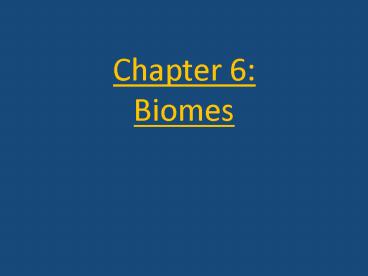Chapter 6: Biomes - PowerPoint PPT Presentation
1 / 21
Title:
Chapter 6: Biomes
Description:
... Tropical Rain Forest Tropical Savanna Desert Temperate Forest Temperate Grassland Chaparral Taiga or Boreal Forest Tundra 1 secondary biome: ... – PowerPoint PPT presentation
Number of Views:162
Avg rating:3.0/5.0
Title: Chapter 6: Biomes
1
Chapter 6 Biomes
2
Chapter 6 Goals
- Explain what biomes are
- Explain how biomes are characterized
- Explain how latitude and altitude affect
vegetation
3
What are the differences?Climate, Biology,
Limiting Factors, Adaptations?
4
Things Change?
- Fossil evidence suggests that the frozen
continent of Antarctica was once covered in
temperate forest.
5
Earths Biomes
- Groups of terrestrial ecosystems that share
biotic and abiotic conditions - 8 primary biomes
- Tropical Rain Forest
- Tropical Savanna
- Desert
- Temperate Forest
- Temperate Grassland
- Chaparral
- Taiga or Boreal Forest
- Tundra
- 1 secondary biome
- Polar Ice
6
Earths Biomes
- Characterized by
- Climate
- Plants
- adapted to biome
- size
- shape
- color
- Animals
- Adapted to biome
- size
- color
7
(No Transcript)
8
(No Transcript)
9
(No Transcript)
10
(No Transcript)
11
- Climate Average conditions, including
temperature and precipitation, over long periods
of time in a given area - Weather Day-to-day conditions in Earths
atmosphere - Climatographs Diagrams that summarize an areas
average monthly temperature and precipitation - Each biome has a set of characteristic organisms
adapted to its particular climate conditions.
12
(No Transcript)
13
La Mesa, CA
14
Philadelphia
15
(No Transcript)
16
Latitude and Altitude
- Latitude is the distance north or south from the
equator - expressed in degrees
- Altitude is the height of an object above a
reference point, such as sea level or the Earths
surface - expressed in meters or feet
17
Latitude and Altitude
- Climate varies with latitude and altitude
- For example, climate gets colder as latitude and
altitude increase. This is why it gets colder as
you move further up a mountain.
18
Latitude and Altitude
- As latitude and altitude increase, biomes and
vegetation change - Trees of tropical rainforests usually grow closer
to the equator - Mosses and lichen of the tundra grow closer to
the poles - The temperate region includes biomes such as
temperate forests and grasslands - usually have moderate temperatures and fertile
soil ideal for agriculture
19
Latitude and Altitude
20
Across the U.S.
21
Chapter 6 Summary
- A biome is a group of terrestrial ecosystems that
share biotic and abiotic conditions. - Biomes are characterized by temperature,
precipitation and type of plants animals. - As latitude and altitude increase, biomes and
vegetation change.































